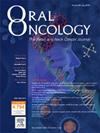Histopathological invasion patterns and prognosis in Oral Squamous Cell Carcinoma: A retrospective analysis of 560 cases
IF 4
2区 医学
Q1 DENTISTRY, ORAL SURGERY & MEDICINE
引用次数: 0
Abstract
Background
Oral Squamous Cell Carcinoma (OSCC) remains a global health issue. Accurate histopathological assessment is vital for improving treatment outcomes. This study explores the impact of perineural, lymphatic, and vascular infiltration (Pn1, L1, V1) on OSCC progression, survival, and recurrence.
Methods
This retrospective study included 560 patients with primary OSCC who underwent curative surgical resection between 2012 and 2023. Data analyzed included demographics, tumor staging, histopathological features, treatment, and follow-up outcomes.
Results
A total of 322 males and 238 females with a mean age of 63.8 years were included. L1 was observed in 40 cases (7.1 %), Pn1 in 53 cases (9.5 %), and V1 in 4 cases (0.7 %). The mean follow-up was 29.7 months, with 3-y ear Overall Survival (OS) at 75.2 % and Recurrence-Free Survival (RFS) at 66.0 %. Multivariate logistic regression showed that contralateral lymph node metastases (CLNM) and ExtraCapsular Extension (ECE) were linked to L1 (OR: 7.83, OR: 2.52), while advanced disease and distant metastasis were strongly associated with Pn1 (OR: 12.70, OR: 6.27). Cox regression analysis revealed CLNM, ECE, and L1 were associated with reduced OS (HR: 2.32, HR: 1.82, HR: 1.90), and CLNM, ECE, L1, and poor differentiation (G3) were associated with reduced RFS (HR: 1.84, HR: 1.80, HR: 2.51, HR: 1.75). CLNM and Pn1 were strong predictors of reduced Distant Metastasis-Free Survival (DMFS).
Conclusion
L1 and Pn1 were associated with worse prognoses in OSCC, affecting OS, RFS, and DMFS. Research is required to clarify their roles, and including these factors in OSCC staging may improve treatment outcomes.
求助全文
约1分钟内获得全文
求助全文
来源期刊

Oral oncology
医学-牙科与口腔外科
CiteScore
8.70
自引率
10.40%
发文量
505
审稿时长
20 days
期刊介绍:
Oral Oncology is an international interdisciplinary journal which publishes high quality original research, clinical trials and review articles, editorials, and commentaries relating to the etiopathogenesis, epidemiology, prevention, clinical features, diagnosis, treatment and management of patients with neoplasms in the head and neck.
Oral Oncology is of interest to head and neck surgeons, radiation and medical oncologists, maxillo-facial surgeons, oto-rhino-laryngologists, plastic surgeons, pathologists, scientists, oral medical specialists, special care dentists, dental care professionals, general dental practitioners, public health physicians, palliative care physicians, nurses, radiologists, radiographers, dieticians, occupational therapists, speech and language therapists, nutritionists, clinical and health psychologists and counselors, professionals in end of life care, as well as others interested in these fields.
 求助内容:
求助内容: 应助结果提醒方式:
应助结果提醒方式:


